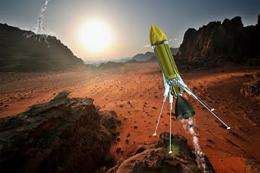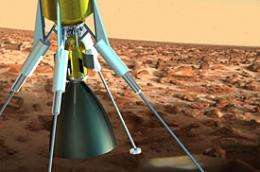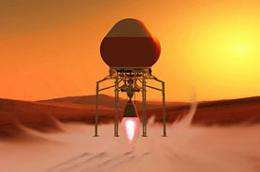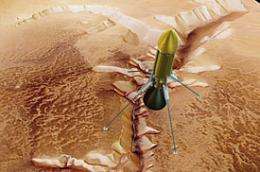Fleet of INL-designed Mars hoppers could swiftly explore other worlds

Mars is our next frontier. We'd like to know whether the Red Planet ever hosted its own life forms – and where it might be able to host human explorers. The twin Mars rovers Spirit and Opportunity have outlasted their planned three-month lifetime and given us our closest look yet at the Martian surface. But the solar-powered rovers have covered only 21 miles of Martian terrain in their combined 11 years of operation, leaving most of the surface unexplored.
Future Mars surface missions could cover more ground with a platform that can hop great distances in the planet's thin atmosphere and weak gravity. Since summer 2009, researchers and student fellows at the Center for Space Nuclear Research at Idaho National Laboratory have been fleshing out designs for a nuclear-powered Mars hopper that can examine one Martian site, jump to another, and repeat, hundreds of times.
"We've got a little guy that we think can hop about 15 kilometers [more than 9 miles] every five to seven days," says Steven Howe, CSNR director. He refers to a hopper design about as big and heavy as an adult emperor penguin and capable of traveling almost 200 times as far as both rovers did in their first five years on Mars.
The lean, long-lived hoppers are designed to wring as much science and exploration as possible out of every ounce. They don't have to carry fuel with them; they can suck up the carbon-dioxide-rich Martian atmosphere and use it as a propellant. On cue, stored heat from a radioisotope power source hits the propellant and rockets the hopper in an arcing path toward its next landing site. Smaller thrusts orient the hopper and soften its landing.

A single rocket launch from Earth could deploy several hoppers at once. A few dozen hoppers could map the entire Martian surface in a few years, Howe says. Hoppers could also serve as a network of weather stations monitoring the Martian climate and could collect a trove of air, rock and soil samples to send back to Earth.
Nuclear-powered space travel
In space travel, every ounce counts. It costs more than $2,000 just to put a pound of payload into Earth orbit, let alone get it all the way to Mars. Whatever we send to other planets has to be as lightweight as possible and built to last.
The CSNR Mars hoppers are the latest in a long line of spacecraft and robots that rely on nuclear technology to help keep them light, long-lived and reliable. Radioisotope Thermoelectric Generators (RTGs or "space batteries") provided steady, lasting power to the Apollo lunar science experiments; to Voyager, Viking and Pioneer space probes; and to the Cassini spacecraft currently orbiting Saturn. The New Horizons mission now en route to Pluto and the Mars Science Laboratory scheduled to launch in November 2011 will both run on RTG power sources assembled and tested at INL for the Department of Energy.
Unlike solar panels, radioisotopes produce steady power even at night or when obscured by Martian dust storms. And unlike chemical fuel, which can burn only once, the same block of radioisotope fuel could be used to launch a hopper over and over again and run its scientific instruments for a decade or more.

Advanced heat storage and transfer technologies allow the CSNR hoppers to use their radioisotope heat source for both power and propulsion. A hopper would run some heat from the radioisotope through a highly efficient Stirling engine and generate electricity to power both onboard scientific instruments and the propellant capture system. The propellant system would freeze and concentrate Martian air into a solid form for convenient storage, eliminating the need for the hopper to carry tanks of propellant from Earth.
Meanwhile, a beryllium core would store radioisotope heat. Once the hopper engine contained enough propellant for another hop, channeling the stored heat directly into the propellant would send the hopper soaring over the Martian surface.
"Nuclear energy is the enabling technology. The isotope allows you to keep doing this for years," says Robert O'Brien, a CSNR research scientist.
CSNR has provided fertile collaborative grounds for researchers to refine and expand the nuclear-thermal hopper concept that O'Brien and Howe launched in summer 2009. The center works with other DOE labs, universities and NASA to help find ways to put INL's national leadership in nuclear expertise to work for space exploration. NASA scientists and CSNR summer fellows from around the country have put their heads together with INL engineers to analyze hopper engines and design hopper missions to explore other planets. Researchers from University of Idaho, Utah State and Oregon State University are contributing to CSNR hopper research. Howe and O'Brien also presented their hopper concept to collaborators at the University of Leicester in the UK. They went on to describe a similar idea in the Proceedings of the Royal Society.
Leaping tall buildings in a single bound
The CSNR Mars hopper team has generated a variety of hopper designs tailored to transport different payloads. The payloads range in size from 10 kilograms – the mass of a medium-size dog – to about 200 kilograms, the mass of either Spirit or Opportunity with a big dog sitting on top.
William Taitano, an INL nuclear engineer, has calculated how much thrust each hopper design can generate. Taitano says a mid-sized hopper, about as heavy as an average American male, could travel five or six kilometers, or more than three miles, in a single bound. At the peak of its leap, the hopper would be soaring more than a kilometer over the Martian surface – easily high enough to clear the tallest Earth building and jump in and out of Martian craters.
The scientific community will ultimately decide what the hoppers will carry, Howe says. While the Mars rovers employ an armada of tools such as cameras, drills and spectrometers that allow them to photograph, sample and analyze the Martian environment, small hoppers might only carry one or a few tools apiece.
Howe envisions having different universities around the world competing to design their own hopper payloads and experiments. "You can have 10 to 20 universities from around the world, hopping around Mars," he says.
But Howe and his team aren't focusing on what the hoppers will take to Mars. They've put a lot more thought into what the hoppers might help bring back.
A piece of Mars
Every once in a while, a piece of Mars makes its way to Earth and falls to the ground as a meteorite. At least one of them contains chemical traces and fossil-like shapes that some scientists believe are evidence of ancient, microscopic Martian life.

Scientists can't afford to wait for more Mars rock with fossils in them to fall to Earth. So a mission to retrieve samples directly from Mars has become the planetary science equivalent of bringing home the Holy Grail.
"Everybody wants a piece of Mars," says O'Brien.
The Mars hopper could play a key role in a sample return mission. A fleet of hoppers could collect Martian rock and dust samples at the source and deliver them to an Earthbound rocket.
The CSNR team plans to keep its hoppers simple and deploy them in large numbers so they can cast a wide net in their search for traces of Martian life.
"They're small, they're cheap, and therefore you can risk the nooks and crannies," Howe says. "If you find a crevice that might have water coming from underneath the surface – then the hopper can get down there."
Where there's water, there could be life. Last summer's CSNR student fellows examined the potential to use modified hoppers to explore Jupiter's large moon Europa. A vast ocean of liquid water may lie beneath the moon's thick, icy crust. Small, nimble hoppers could get down into deep cracks in the crust and take samples of any seawater that wells up into the cracks.
A trip to Europa is pretty far in the future. But a functioning nuclear Mars hopper may be much closer. INL researchers have already done extensive work on most of the hopper technologies, including radioisotope batteries, Stirling generators, heat transfer, and sturdy engine materials that can withstand the sudden impacts and high temperatures associated with hopper operations. Parts of the beryllium heat transfer core have been manufactured and are waiting to be tested. Within two years, Howe and his collaborators hope to take a prototype hopper engine out to the INL desert site for a test hop.
Taitano is looking forward to that first hop. When asked to rate the coolness of the hopper project on a scale from 1 to 10, he didn't hesitate to answer: "It's a 20."
Provided by Idaho National Laboratory

















